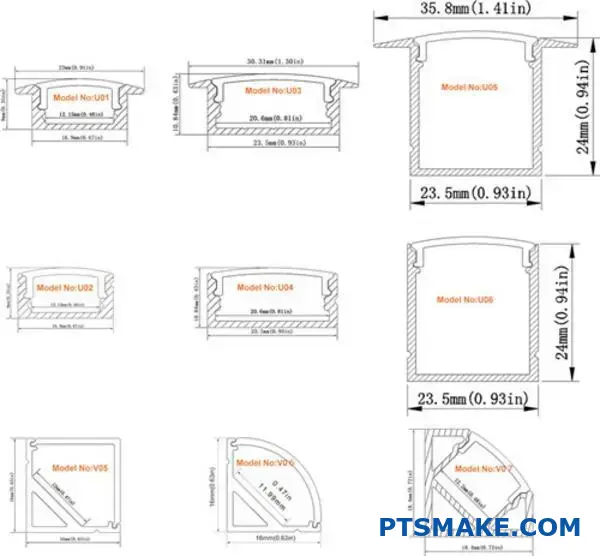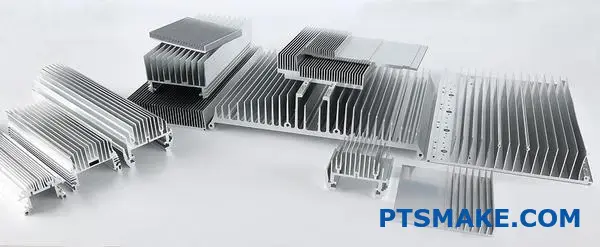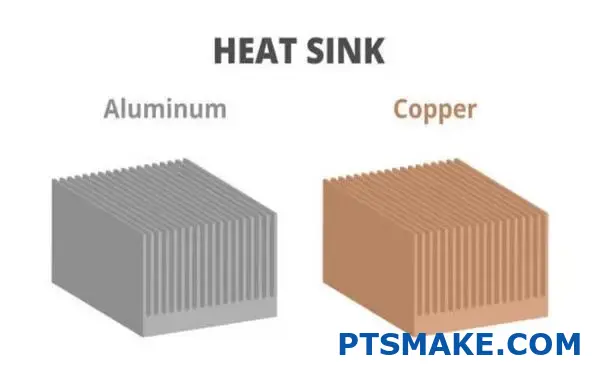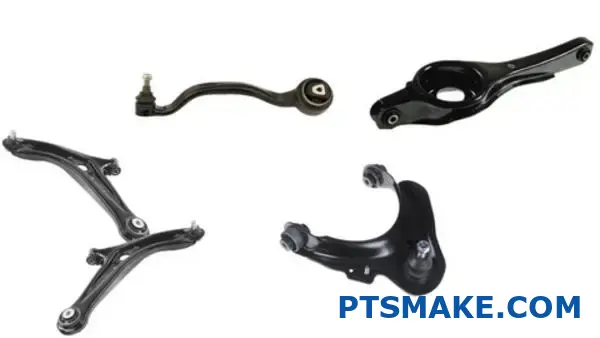## What Is The Difference Between Skived And Extruded Heat Sinks?
Confused about which heat sink manufacturing process will work best for your thermal management needs? Many engineers struggle to choose between skived and extruded heat sinks, often selecting the wrong option due to misunderstanding their fundamental differences. This can lead to overheating issues and reduced product reliability.
Skived heat sinks offer higher fin density and thermal efficiency compared to extruded heat sinks. Skiving creates thinner, closely-packed fins from solid metal blocks, while extrusion forces aluminum through a die to form simpler, more cost-effective heat sink designs.
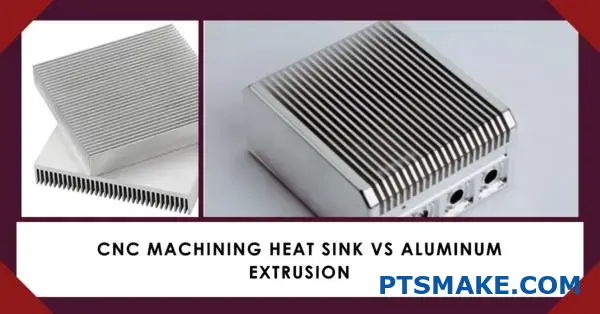
I’ve worked with both types extensively in our manufacturing facilities at PTSMAKE. The right choice depends on your specific application requirements. If you need maximum cooling in a compact space, skived sinks typically outperform. For simpler applications with budget constraints, extruded options often make more sense. Let me explain the key differences in more detail below.
Are Heat Sinks Extruded?
Have you ever wondered why some electronic devices overheat while others stay cool under pressure? The secret might be in their heat sinks, but do you know how these crucial cooling components are actually made? The manufacturing method can make all the difference between a device that fails prematurely and one that performs reliably for years.
Yes, many heat sinks are extruded, particularly aluminum heat sinks. The extrusion process forces aluminum through a die to create the heat sink profile in a single operation. This manufacturing method is popular because it offers a good balance of cost-effectiveness, thermal performance, and design flexibility for many cooling applications.
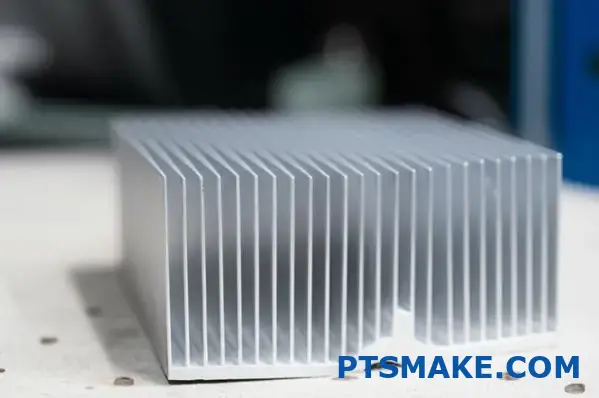
The Fundamentals of Extruded Heat Sink Manufacturing
Extrusion is one of the most common methods for producing heat sinks, particularly for applications that don’t require extremely high cooling performance. In my years at PTSMAKE, I’ve seen the extrusion process become increasingly sophisticated, yet the basic principles remain the same.
The Extrusion Process Explained
The aluminum extrusion process begins with heating aluminum billets to approximately 800-925°F (427-496°C). At this temperature, the aluminum becomes malleable but not molten. The heated billet is then forced through a specially designed die using a hydraulic press that can exert tremendous pressure—often between 100 and 15,000 tons depending on the complexity and size of the profile.
What makes this process particularly valuable for heat sink manufacturing is that the entire cross-section is formed simultaneously as the aluminum passes through the die. Once extruded, the profiles are cooled, straightened, and cut to the desired length.
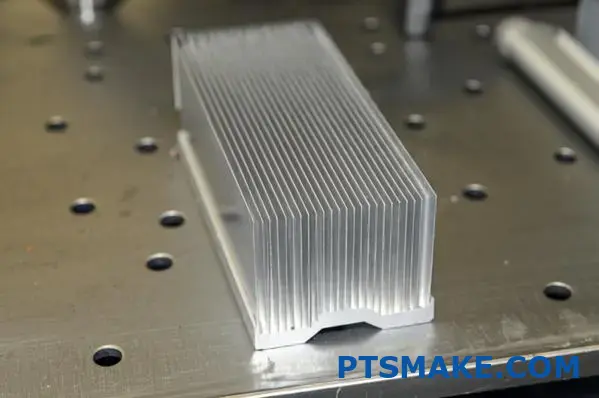
Advantages of Extruded Aluminum Heat Sinks
Extruded heat sinks offer several benefits that make them the preferred choice for many thermal management applications:
| Преимущество | Описание |
|---|---|
| Экономическая эффективность | Lower tooling and production costs compared to other methods |
| Гибкость конструкции | Ability to create complex cross-sections in a single operation |
| Good Thermal Performance | Adequate for many general cooling applications |
| Свойства материала | Aluminum offers excellent thermal conductivity to weight ratio |
| Скорость производства | High output rates for large volume requirements |
As someone who has overseen the production of thousands of heat sinks, I can attest that the cost advantage becomes particularly significant in larger production runs where the initial die cost is amortized across many units.
Limitations of Extrusion for Heat Sink Manufacturing
Despite its popularity, the extrusion process does have inherent limitations that engineers should be aware of when designing cooling solutions.
Physical Constraints of Extrusion
Сайт aspect ratio1 of fins (height-to-width) is limited in extrusion due to the physics of metal flow through the die. Typically, this ratio cannot exceed 10:1, meaning very tall, thin fins are difficult to produce via extrusion alone. Additionally, there are minimum thickness requirements—usually around 1.5mm—to ensure the aluminum flows properly through the die without causing defects.
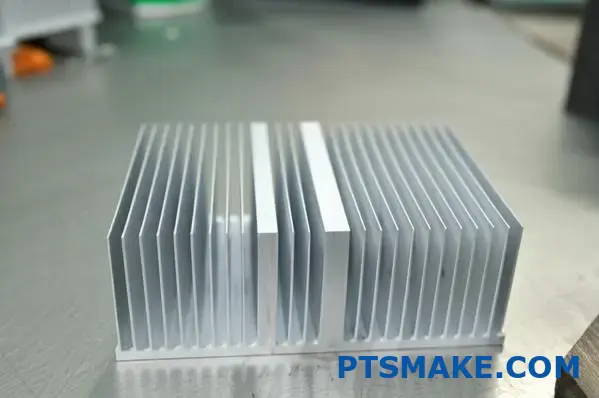
Соображения по производительности
While extruded heat sinks perform adequately in many applications, they may not be sufficient for high-power density electronics. The limitations on fin density and thickness directly impact the surface area available for heat dissipation, which is a critical factor in thermal performance.
Alternative Heat Sink Manufacturing Methods
When extrusion doesn’t meet performance requirements, several alternative manufacturing methods come into play:
Skived Heat Sinks
Skiving involves cutting fins from a solid block of metal (usually copper or aluminum). This process can create much thinner fins and higher fin densities than extrusion, resulting in significantly improved thermal performance. At PTSMAKE, we often recommend skived heat sinks for applications where maximum cooling in a limited space is required.
Die-Cast Heat Sinks
Die casting involves injecting molten metal into a mold cavity. This method allows for more complex base geometries than extrusion but typically can’t achieve the same fin density or aspect ratios. Die casting is particularly useful when the base of the heat sink needs intricate features or mounting provisions.

Bonded Fin Heat Sinks
For applications requiring extremely high performance, bonded fin heat sinks offer an excellent solution. This method involves attaching individually manufactured fins to a base plate, allowing for very high fin densities and the use of different materials for the base and fins if desired.
Selecting the Right Heat Sink Manufacturing Process
Choosing between extruded and other heat sink types requires careful consideration of several factors:
| Фактор | Extruded Heat Sinks | Альтернативные методы |
|---|---|---|
| Тепловые характеристики | Good for general applications | Superior for high-power applications |
| Стоимость | Lower, especially at volume | Higher, but justified by performance |
| Сложность конструкции | Limited by extrusion constraints | Greater flexibility |
| Объем производства | Excellent for high volume | Some alternatives better for low volume |
| Весовые соображения | Легкий | Often heavier due to material or design |
The decision ultimately comes down to balancing thermal requirements against budget constraints. In my experience, many engineers initially over-specify their thermal solutions, leading to unnecessary costs. Conversely, others underestimate their cooling needs, resulting in reliability issues down the line.
Industry Applications for Extruded Heat Sinks
Extruded aluminum heat sinks find their place in numerous industries and applications:
- Consumer electronics (computers, audio equipment)
- LED lighting fixtures
- Power supplies and inverters
- Automotive electronic components
- Телекоммуникационное оборудование
- Industrial control systems
For these applications, the balance of cost, performance, and reliability offered by extruded heat sinks often represents the optimal solution.
Is Extruded Aluminum Heat Treatable?
Have you ever designed a project using extruded aluminum, only to wonder if you could enhance its strength through heat treatment? Many engineers face this dilemma when balancing between the convenience of extrusion and the need for improved mechanical properties. Getting this wrong can lead to component failure or unnecessary manufacturing costs.
Yes, extruded aluminum is heat treatable, but only if it belongs to heat-treatable alloy series (2xxx, 6xxx, 7xxx). The 6061 and 6063 alloys, commonly used for extrusions, respond particularly well to heat treatment processes like solution heat treatment and aging, which significantly improve their strength properties while maintaining the complex profiles achieved during extrusion.
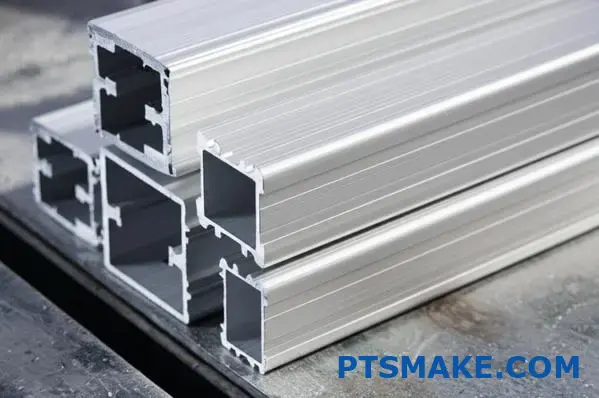
Understanding Heat Treatment for Extruded Aluminum
Heat treatment transforms the microstructure of aluminum alloys, enhancing their mechanical properties through controlled heating and cooling cycles. Having worked with aluminum extrusions for various thermal management solutions, I’ve seen firsthand how proper heat treatment can make or break a project’s success.
Heat-Treatable vs. Non-Heat-Treatable Aluminum Alloys
Not all aluminum alloys respond to heat treatment the same way. The distinction primarily depends on their chemical composition:
| Серия сплавов | Heat Treatable? | Общие приложения | Primary Alloying Elements |
|---|---|---|---|
| 1xxx (Pure) | Нет | Electrical conductors, Chemical equipment | 99%+ Aluminum |
| 2xxx | Да | Aerospace, Military | Медь |
| 3xxx | Нет | Heat exchangers, Cookware | Марганцовка |
| 4xxx | Partially | Welding rods, Automotive | Кремний |
| 5xxx | Нет | Marine, Architecture | Магний |
| 6xxx | Да | Extrusions, Heat sinks | Magnesium, Silicon |
| 7xxx | Да | Aircraft structures, High-stress parts | Цинк |
The 6xxx series alloys are particularly popular for extrusion because they combine excellent extrudability with good response to heat treatment. At PTSMAKE, we frequently work with 6061 and 6063 for custom extruded aluminum heat sinks, as they provide an optimal balance of thermal conductivity and mechanical strength after heat treatment.
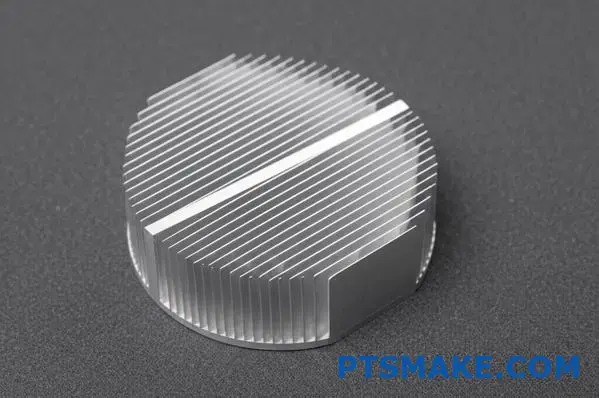
The Heat Treatment Process for Extruded Aluminum
The heat treatment of extruded aluminum typically involves three main stages:
- Термическая обработка раствором: Heating the aluminum to approximately 980°F (525°C) to dissolve alloying elements into solid solution
- Закаливание: Rapidly cooling the material to room temperature, usually in water, to create a supersaturated solid solution
- Старение: Either natural aging at room temperature or artificial aging at elevated temperatures (typically 320-400°F or 160-205°C) to form strengthening precipitates
This process significantly improves mechanical properties by creating microscopic precipitates that impede dislocation movement within the aluminum’s crystal structure.
Impact of Heat Treatment on Extruded Aluminum Properties
Heat treatment can dramatically transform the properties of extruded aluminum profiles, often doubling or even tripling their strength compared to the as-extruded condition.
Mechanical Property Improvements
For example, 6061 aluminum in its as-extruded condition (T1 temper) has a typical tensile strength of about 18-20 ksi (125-140 MPa). After proper heat treatment to T6 temper, this increases to approximately 42-45 ksi (290-310 MPa). This strength boost comes with minimal dimensional changes, preserving the complex cross-sectional geometries achieved during the extrusion process.
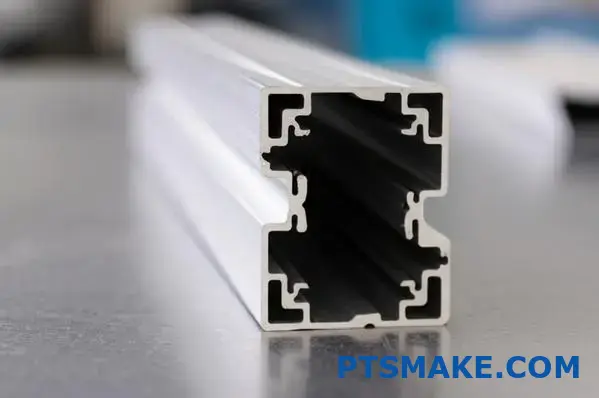
Thermal Conductivity Considerations
When designing extruded aluminum heat sinks, thermal conductivity is just as important as mechanical strength. Interestingly, heat treatment has a relatively minor effect on thermal conductivity compared to its impact on strength. For 6063 aluminum, the thermal conductivity typically decreases by only about 5-10% after heat treatment to T6 condition, maintaining excellent heat dissipation capabilities.
Challenges in Heat Treating Extruded Aluminum
While heat treatment offers significant benefits, it’s not without challenges:
Distortion and Warping
Long, thin extrusions with complex cross-sections can warp during the rapid quenching stage of heat treatment. In my experience working with custom heat sink designs, this has occasionally necessitated additional straightening operations or even redesigns with more uniform wall thicknesses to minimize distortion.
Uneven Properties
Thicker sections cool more slowly during quenching than thinner ones, potentially leading to variations in mechanical properties throughout a complex extrusion. For critical applications, we sometimes recommend designing extrusions with more uniform wall thicknesses or considering post-machining from plate stock for parts requiring extremely consistent properties.
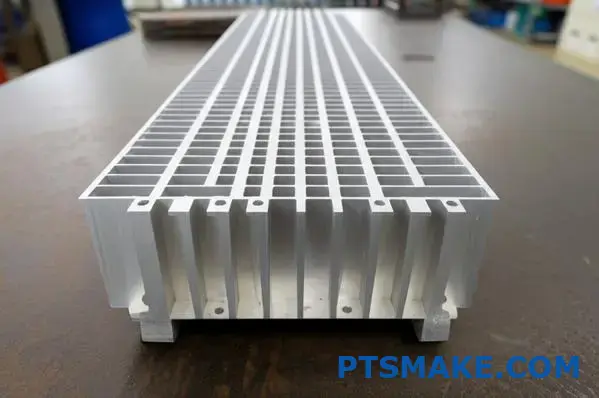
Corrosion Resistance Tradeoffs
While heat treatment enhances strength, it can sometimes reduce corrosion resistance, particularly in marine environments. For applications where both strength and corrosion resistance are critical, alloy selection becomes especially important. Sometimes a slightly lower-strength alloy with better corrosion properties may be the better choice for long-term reliability.
Common Heat Treatments for Extruded Aluminum Heat Sinks
For thermal management applications like heat sinks, several temper designations are commonly used:
- T4: Solution heat treated and naturally aged
- T5: Cooled from extrusion and artificially aged
- T6: Solution heat treated and artificially aged (provides highest strength)
The T6 temper is often preferred for heat sinks that need to withstand mechanical stresses while maintaining dimensional stability at elevated operating temperatures. The T5 temper offers a good compromise between improved strength and manufacturing cost when ultimate strength isn’t required.
Optimizing Extruded Aluminum Heat Sinks Through Heat Treatment
From my experience developing cooling solutions for various industries, the decision to heat treat extruded aluminum heat sinks depends on several application-specific factors:
- Диапазон рабочих температур
- Mechanical stresses (mounting forces, vibration)
- Weight and space constraints
- Чувствительность к затратам
- Объем производства
For high-performance computing applications where heat sinks might be subjected to significant mechanical stress from mounting pressure or shock and vibration, heat-treated 6061-T6 extrusions often provide the best balance of thermal performance and mechanical reliability.
What Are Extruded Heatsinks Made Of?
Ever stared at a hot-running device and wondered what’s keeping it from melting down? Or maybe you’ve held a heatsink and questioned what exactly gives this lightweight metal component its impressive cooling ability? The right material can mean the difference between optimal performance and catastrophic thermal failure.
Extruded heatsinks are primarily made of aluminum alloys, with 6063 and 6061 being the most common choices. These alloys offer an excellent balance of thermal conductivity, mechanical strength, and extrudability. The aluminum is forced through a die under pressure to create the heatsink’s characteristic fin structure that maximizes surface area for heat dissipation.
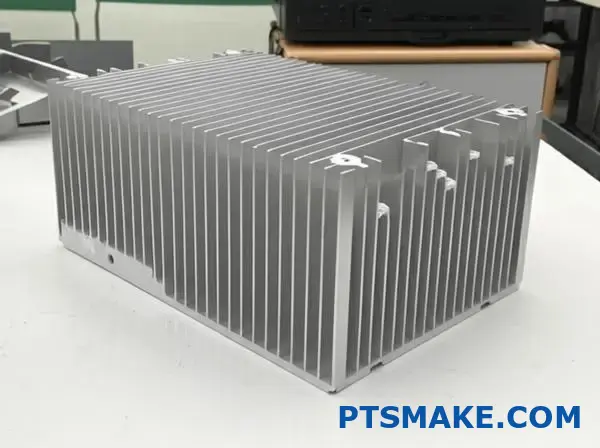
The Primary Materials in Extruded Heatsinks
Having worked with thermal management solutions for various industries, I’ve seen firsthand how material selection impacts heatsink performance. The right material choice is crucial for balancing heat dissipation needs with manufacturing constraints.
Aluminum: The Standard Bearer
Aluminum dominates the extruded heatsink market for several compelling reasons. With a thermal conductivity of about 205-237 W/m·K (depending on the specific alloy), aluminum efficiently transfers heat away from critical components. What makes aluminum particularly suitable for extrusion is its excellent formability at elevated temperatures.
The most common aluminum alloys used for extruded heatsinks include:
| Сплав | Теплопроводность (Вт/м-К) | Основные характеристики | Типовые применения |
|---|---|---|---|
| 6063 | 201-218 | Excellent extrudability, good surface finish | Бытовая электроника, светодиодное освещение |
| 6061 | 167-173 | Better strength, good machinability | Telecommunications, power supplies |
| 6005 | 170-180 | Enhanced strength, moderate extrudability | Industrial electronics, military applications |
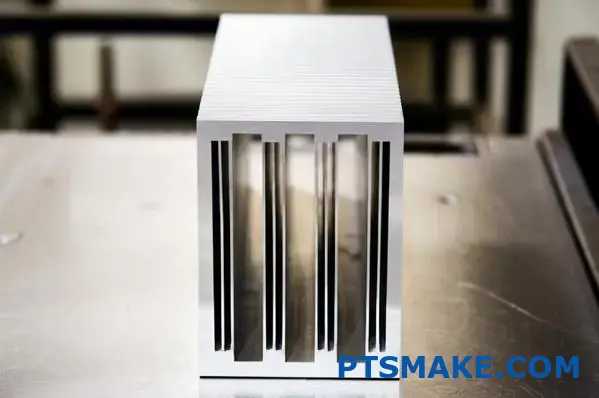
Why 6063 Aluminum Rules Heatsink Extrusions
In my years working with thermal solutions at PTSMAKE, I’ve found that 6063 aluminum is particularly popular for extruded heatsinks. Its magnesium and silicon content creates the perfect balance of properties:
- Superior extrudability: Flows exceptionally well through complex dies
- Excellent thermal performance: Among the highest thermal conductivity in the 6xxx series
- Привлекательный внешний вид: Takes well to anodizing treatments
- Adequate strength: Sufficient for most thermal applications
- Экономическая эффективность: More economical than higher-performance alloys
This combination makes 6063 the go-to choice for approximately 70% of the extruded heatsinks we manufacture.
Alternative Materials for Specialized Applications
While aluminum dominates, other materials are occasionally used for specialized extruded heatsink applications:
Медные сплавы
Copper offers superior thermal conductivity (385-400 W/m·K) compared to aluminum. However, copper extrusions are less common due to:
- Higher material cost (3-4 times more expensive than aluminum)
- Greater weight (copper is about 3 times denser than aluminum)
- More challenging extrusion process requiring higher temperatures and pressures
At PTSMAKE, we typically recommend copper-based solutions only for the most demanding thermal applications where the performance advantage justifies the cost premium.

Aluminum-Silicon Carbide (AlSiC) Composites
For specialized applications requiring коэффициент теплового расширения2 matching with electronic components (particularly in power electronics), metal matrix composites like AlSiC may be used. These materials combine aluminum with silicon carbide particles to create composites with tailored properties. However, these are rarely extruded and instead are typically produced through casting or powder metallurgy processes.
Manufacturing Process Influence on Material Properties
The extrusion process itself affects the final properties of heatsink materials. Understanding these effects helps engineers design more effective thermal solutions.
Grain Structure and Directionality
During extrusion, aluminum grains become elongated in the direction of material flow, creating anisotropic thermal conductivity. In my experience, this can result in thermal conductivity values that are 5-10% higher in the extrusion direction compared to the transverse direction.
For critical applications, we account for this directionality when orienting heatsinks relative to heat sources and airflow.
Возможности термической обработки
Most aluminum heatsinks undergo some form of heat treatment after extrusion to enhance strength and stability:
- T5 temper: Artificially aged after extrusion for moderate strength improvement
- T6 temper: Solution heat-treated and artificially aged for maximum strength
The thermal conductivity difference between these treatments is minimal (typically less than a 5% reduction with T6 treatment), while mechanical properties can improve significantly.
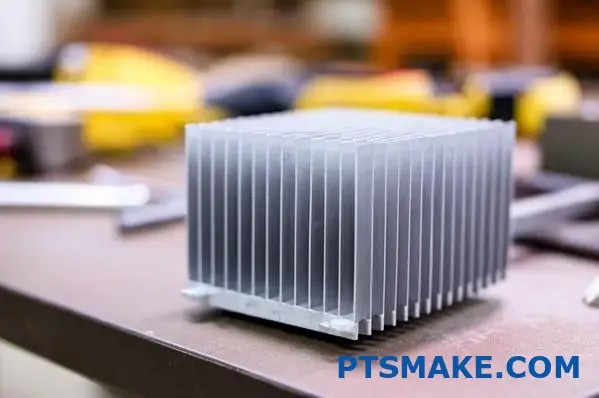
Surface Treatments for Enhanced Performance
Raw aluminum heatsinks often undergo surface treatments that affect both performance and appearance:
Анодирование
Anodizing creates a controlled oxide layer on the aluminum surface that:
- Повышает коррозионную стойкость
- Provides electrical insulation
- Allows for color dyeing
- Slightly reduces thermal conductivity (typically 1-3%)
For most applications, the protective benefits of anodizing outweigh the minor reduction in thermal performance. At PTSMAKE, we typically recommend black anodizing for heatsinks in visible applications, as it also improves radiative heat transfer through increased emissivity.
Никелирование
For environments where corrosion resistance is paramount, nickel plating might be applied. This creates a barrier that protects the aluminum substrate but comes with a modest thermal performance penalty due to the plating’s lower thermal conductivity.
Material Selection Considerations for Specific Applications
The optimal heatsink material depends heavily on application requirements. In my consulting work with clients, I typically consider:
Бытовая электроника
For consumer devices where cost and weight are critical, standard 6063 aluminum is usually the best choice. The extrusion process allows for cost-effective production of complex fin structures that maximize cooling in compact spaces.
Светодиодное освещение
LED applications often benefit from 6063 aluminum with black anodizing. The improved emissivity helps with radiative cooling, while the material’s formability allows for circular or custom-shaped extrusions that integrate directly with fixture designs.
Силовая электроника
High-power applications might justify more expensive materials like 6061-T6 or even copper-based solutions. The additional cost is offset by improved reliability and the ability to handle higher power densities in converter and inverter applications.
Automotive Electronics
Automotive environments demand excellent vibration resistance and thermal cycling capability. For these applications, we often recommend 6061 aluminum with appropriate mounting considerations to handle the harsh conditions found under the hood.
Cost-Benefit Analysis of Material Choices
When advising clients on heatsink material selection, I always emphasize the importance of considering total system cost rather than just material price. A slightly more expensive aluminum alloy that allows for 10% better thermal performance might enable:
- Smaller overall heatsink size
- Reduced fan requirements or even passive cooling
- Extended component lifespan due to lower operating temperatures
- Improved product reliability
This holistic approach ensures the most cost-effective solution for the specific application rather than simply defaulting to the cheapest available material.
How Do You Heat Treat Aluminum Extrusions?
Have you ever struggled with aluminum extrusions that weren’t quite strong enough for your application? Or wondered why some aluminum components can withstand high stress while others bend or break? The difference often lies in a critical manufacturing step that transforms ordinary aluminum into something extraordinary.
Heat treating aluminum extrusions involves a three-step process: solution heat treatment (heating to approximately 980°F), quenching (rapid cooling in water), and aging (either naturally at room temperature or artificially at 320-400°F). This process significantly enhances the strength and hardness of heat-treatable aluminum alloys like 6061 and 6063 while maintaining their extruded shapes.
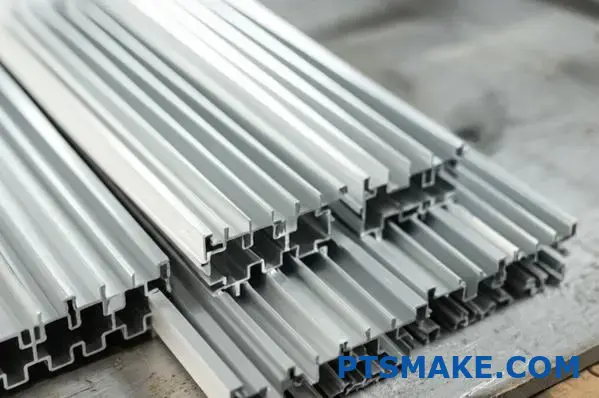
The Science Behind Heat Treating Aluminum Extrusions
Heat treatment fundamentally changes aluminum at the microstructural level, transforming relatively soft extruded profiles into components with significantly enhanced mechanical properties. I’ve overseen countless heat treatment operations, and the transformation never fails to impress me.
Understanding Precipitation Hardening
The most common heat treatment for aluminum extrusions involves precipitation hardening (also called age hardening). This process works because certain aluminum alloys contain elements like copper, magnesium, and silicon that have varying solubility in aluminum at different temperatures.
During solution heat treatment, these alloying elements dissolve into the aluminum matrix. Quenching "locks" these elements in place, creating an unstable supersaturated solution. During aging, these elements form microscopic precipitates that block dislocation movement within the crystal structure, significantly strengthening the material.
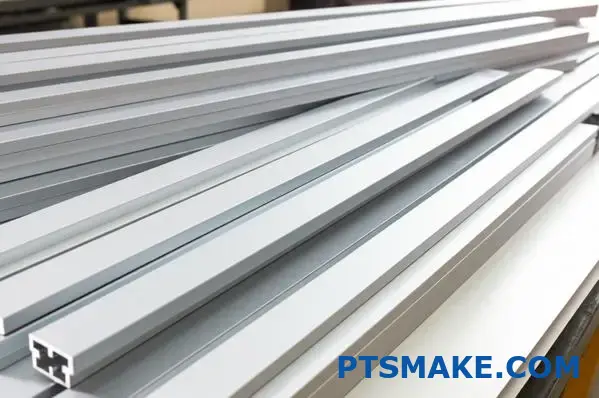
Heat-Treatable vs. Non-Heat-Treatable Aluminum Alloys
Not all aluminum alloys respond to heat treatment. The capability depends entirely on their chemical composition:
| Серия сплавов | Heat Treatable? | Common Extrusion Applications |
|---|---|---|
| 1xxx (Pure) | Нет | Electrical conductors, decorative trim |
| 2xxx | Да | Aerospace components, high-strength applications |
| 3xxx | Нет | Heat exchangers, architectural applications |
| 4xxx | Partially | Welding rods (rarely extruded) |
| 5xxx | Нет | Marine applications, architectural products |
| 6xxx | Да | Structural components, heat sinks, architectural profiles |
| 7xxx | Да | Aerospace structures, high-performance applications |
The 6xxx series alloys, particularly 6061 and 6063, are the workhorses of the aluminum extrusion industry. These alloys contain magnesium and silicon, which form strengthening Mg₂Si precipitates during heat treatment.
The Heat Treatment Process Step-by-Step
At PTSMAKE, we follow a carefully controlled heat treatment process for aluminum extrusions that consists of three critical stages:
1. Solution Heat Treatment
This first stage involves heating the aluminum extrusions to approximately 980°F (525°C) and holding them at this temperature for a sufficient time (typically 1-2 hours, depending on section thickness). This dissolves the alloying elements into solid solution within the aluminum matrix.
The temperature control must be precise—too low and not all precipitates dissolve; too high and the aluminum may partially melt, causing irreversible damage. This is why professional heat treatment facilities use computer-controlled furnaces with multiple temperature monitoring points.
2. Quenching
After solution heat treatment, the extrusions must be rapidly cooled to room temperature, typically in water. This "freezes" the alloying elements in place, creating a supersaturated solid solution.
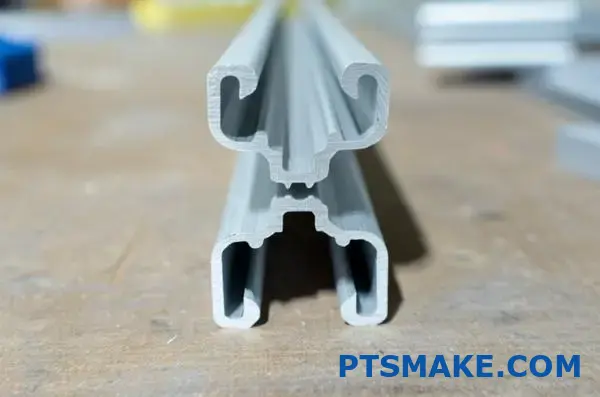
Quenching is perhaps the most critical step, as it must happen quickly enough to prevent the alloying elements from forming coarse precipitates, which would reduce strengthening potential. For complex extrusions, the quenching process needs careful management to minimize distortion.
In my experience, the most common issue during quenching is warping, especially with long, thin-walled extrusions. To combat this, we sometimes use fixtures to maintain straightness during quenching or perform post-quench straightening operations.
3. Aging
The final step is aging, which comes in two varieties:
- Natural aging: Occurs at room temperature over days or weeks
- Artificial aging: Takes place at elevated temperatures (typically 320-400°F or 160-205°C) for several hours
Artificial aging accelerates the formation of strengthening precipitates and generally produces higher strength than natural aging. The time and temperature of artificial aging determine the final properties—higher temperatures typically result in faster aging but potentially lower peak strength.
For 6061 extrusions, a typical artificial aging cycle might be 8 hours at 350°F (177°C) to achieve T6 temper. However, the exact parameters vary based on section thickness and desired properties.
Common Temper Designations for Aluminum Extrusions
The heat treatment process results in different temper designations that indicate the material’s condition:
| Temper | Описание | Typical Properties Compared to As-Extruded |
|---|---|---|
| F | As fabricated | Baseline (no controlled properties) |
| T1 | Cooled from extrusion and naturally aged | Modest strength increase |
| T4 | Solution heat treated and naturally aged | Significant strength increase, good formability |
| T5 | Cooled from extrusion and artificially aged | Good strength, economical process |
| T6 | Solution heat treated and artificially aged | Максимальная прочность и твердость |
| T651 | T6 + stress relief by stretching | Improved straightness, reduced internal stress |
T6 is the most common temper for structural and high-performance applications, as it provides the highest strength. For 6061 aluminum, heat treatment can increase yield strength from approximately 8 ksi (55 MPa) in the as-extruded condition to about 35 ksi (240 MPa) in the T6 condition—a remarkable improvement.
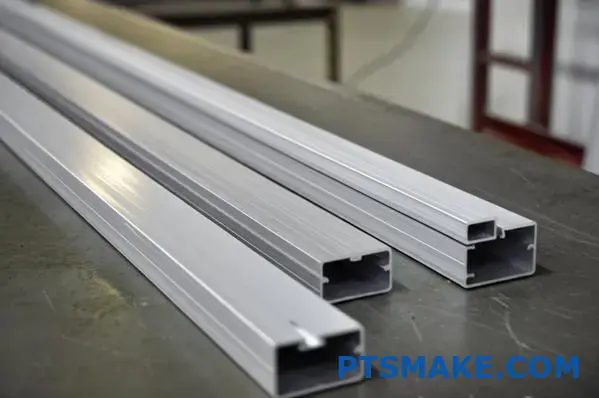
Challenges and Considerations in Heat Treating Aluminum Extrusions
While heat treatment offers substantial benefits, it also presents several challenges that require careful management:
Контроль искажений
The rapid temperature changes during heat treatment can cause warping, especially in complex or asymmetric profiles. At PTSMAKE, we’ve developed several strategies to minimize distortion:
- Using support fixtures during heat treatment
- Designing extrusions with uniform wall thicknesses where possible
- Incorporating straightening operations after heat treatment
- Applying the T651 temper (stretching after heat treatment) for critical straightness requirements
Изменения размеров
Heat treatment can cause slight dimensional changes in aluminum extrusions. Typically, 6061 and 6063 extrusions grow by approximately 0.1-0.3% during heat treatment. For precision applications, we either account for this growth in the design or perform final machining operations after heat treatment.
Особенности отделки поверхности
Solution heat treatment and quenching can affect the surface appearance of aluminum extrusions. Proper cleaning before heat treatment is essential to prevent staining. Additionally, the temperature and water quality during quenching can significantly impact the final surface appearance.
For architectural applications where appearance is critical, we often recommend anodizing after heat treatment to achieve a consistent, attractive finish that also provides corrosion protection.
Оптимизация термообработки для конкретных применений
Different applications require different approaches to heat treatment:
Структурные компоненты
For structural applications, maximizing strength is typically the priority. Full T6 heat treatment provides the highest strength and is generally worth the additional processing cost for safety-critical components.
Thermal Management Applications
Для extruded aluminum heat sink applications, the choice of heat treatment involves balancing mechanical requirements with thermal conductivity. While heat treatment slightly reduces thermal conductivity (by about 5-10%), the improved mechanical properties often outweigh this drawback for applications requiring mounting strength or operation in high-vibration environments.
Cost-Sensitive Applications
When cost is a major concern, the T5 temper (cooling from extrusion followed by artificial aging) offers a good compromise. It skips the solution heat treatment and quenching steps while still providing meaningful strength improvement over the as-extruded condition.
Quality Control in Aluminum Extrusion Heat Treatment
Consistent quality in heat treatment requires rigorous monitoring and testing:
- Испытание на твердость provides a quick verification of heat treatment effectiveness
- Испытание на растяжение confirms mechanical properties meet specifications
- Electrical conductivity measurements can indirectly verify proper heat treatment
- Металлографическое исследование reveals microstructural characteristics
At PTSMAKE, we conduct regular audits of our heat treatment processes to ensure consistency and compliance with standards like AMS-H-6088 and ASTM B597.
The Future of Aluminum Extrusion Heat Treatment
Heat treatment technology continues to evolve, with several promising developments:
- Computer modeling to predict distortion and optimize fixture design
- Печи с контролируемой атмосферой for improved surface quality
- Quenchants beyond water with adjusted cooling rates for reduced distortion
- Precision aging techniques for customized property profiles
These advancements are making it possible to heat treat increasingly complex extrusions with better dimensional control and more consistent properties.
Which Material Is Best For A Heat Sink?
Have you ever watched your device slow down or shut off due to overheating? The frustration of thermal throttling can ruin productivity and gaming experiences alike. Choosing the wrong heat sink material for your application is like bringing a knife to a gunfight – it simply won’t handle the thermal load when you need it most.
Aluminum is generally the best material for most heat sinks, particularly extruded aluminum heat sinks using alloys like 6063 and 6061. While copper offers superior thermal conductivity (approximately 1.7 times better than aluminum), aluminum provides the optimal balance of thermal performance, weight, cost-effectiveness, and manufacturing versatility for most cooling applications.
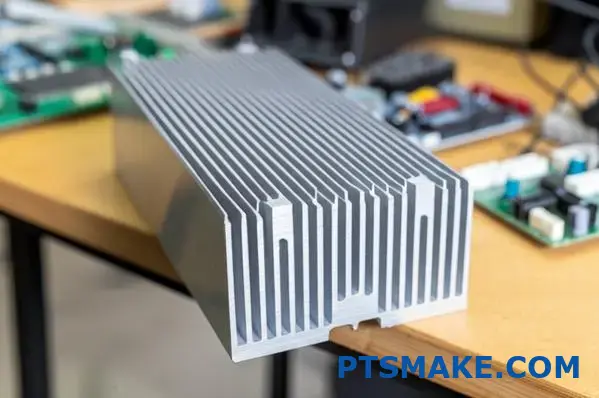
Comparing Heat Sink Materials: Making the Right Choice
When evaluating heat sink materials, several properties determine their effectiveness in thermal management applications. I’ve worked with countless thermal solutions over the years, and understanding these fundamental properties is essential for making informed decisions.
Thermal Conductivity: The Foundation of Heat Transfer
Thermal conductivity measures a material’s ability to conduct heat, expressed in watts per meter-Kelvin (W/m·K). This property is perhaps the most critical for heat sink performance:
| Материал | Теплопроводность (Вт/м-К) | Relative Performance |
|---|---|---|
| Медь | 385-400 | Excellent (Benchmark) |
| Алюминий | 167-237 (varies by alloy) | Good (40-60% of copper) |
| Aluminum Alloy 6063 | 201-218 | Very good for aluminum |
| Aluminum Alloy 6061 | 167-173 | Good for aluminum |
| Композиты из углеродного волокна | 20-500 (direction-dependent) | Переменная |
| Нержавеющая сталь | 12-45 | Бедный |
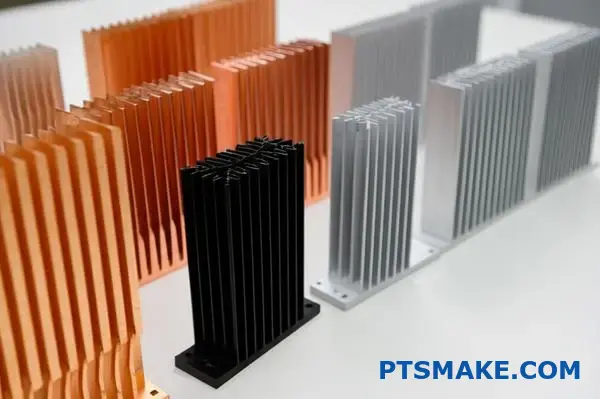
While copper clearly leads in raw thermal conductivity, this is just one factor in the complex equation of heat sink material selection.
Плотность и вес
The density of a heat sink material directly impacts the final product weight, which can be critical for applications like laptops, mobile devices, or aerospace components:
- Copper: ~8.96 g/cm³
- Aluminum: ~2.70 g/cm³
- Carbon composites: ~1.5-2.0 g/cm³
At PTSMAKE, I’ve seen projects where switching from copper to aluminum reduced heat sink weight by over 65% while still meeting thermal requirements after optimizing the design. This weight reduction can be crucial for portable electronics and applications where total system weight matters.
Cost-Effectiveness and Manufacturing Considerations
Material costs significantly impact final product pricing. Copper typically costs 3-4 times more than aluminum, making it prohibitively expensive for many mass-market applications. Beyond raw material costs, manufacturing processes also vary in complexity and cost depending on the material:
- Алюминий: Excellent extrudability, easy machining, and good die-casting properties
- Медь: More difficult to extrude, requires more energy to machine, and often necessitates additional processing
- Composites: Generally require specialized manufacturing techniques

Aluminum: The Standard Bearer for Extruded Heat Sinks
Aluminum has emerged as the predominant material for extruded heat sinks for several compelling reasons.
The Aluminum Advantage
The 6000-series aluminum alloys (particularly 6063 and 6061) offer an excellent balance of properties that make them ideal for heat sink applications:
- Excellent extrudability: Creates complex fin geometries that increase surface area
- Хорошая теплопроводность: Sufficient for most applications
- Низкая плотность: About one-third the weight of copper
- Устойчивость к коррозии: Naturally forms a protective oxide layer
- Экономическая эффективность: Both in raw material and processing costs
- Surface finishing options: Easily anodized to improve appearance and durability
The extrusion process allows for the creation of complex cross-sections that would be prohibitively expensive to produce through machining alone. This gives aluminum heat sinks a significant advantage in the crucial surface-area-to-volume ratio that drives cooling efficiency.
Aluminum Alloy Selection for Heat Sinks
Not all aluminum alloys are created equal when it comes to heat sink performance:
| Сплав | Основные характеристики | Лучшие приложения |
|---|---|---|
| 6063 | Higher thermal conductivity, excellent extrudability, better surface finish | Consumer electronics, LED lighting, general-purpose cooling |
| 6061 | Higher strength, good machinability, slightly lower thermal conductivity | Structural heat sinks, high-vibration environments, automotive |
| 1050 | Very high purity (99.5% Al), excellent thermal conductivity, lower strength | Pure thermal applications where strength isn’t critical |
The optimal choice depends on your specific application requirements and constraints.
Copper: Superior Performance at a Premium
Despite aluminum’s dominance, copper remains the material of choice for high-performance thermal management applications where cost and weight are secondary concerns.
When Copper Makes Sense
Copper heat sinks deliver superior thermal performance in several scenarios:
- High heat flux applications: When dealing with concentrated heat sources generating significant thermal energy in a small area
- Space-constrained designs: When the available volume for the heat sink is severely limited
- Performance-critical systems: Where thermal performance takes absolute priority over cost and weight
- Vapor chambers and heat pipes: Where copper’s superior thermal conductivity enables efficient heat spreading

Copper’s Limitations
Despite its thermal advantages, copper has significant drawbacks that limit its widespread adoption:
- Weight penalty: Copper heat sinks are approximately three times heavier than equivalent aluminum designs
- Manufacturing challenges: More difficult to extrude and machine than aluminum
- Проблемы с окислением: Develops a patina over time that can impact thermal performance
- Cost premium: Significantly more expensive in both raw material and processing
In my experience at PTSMAKE, we typically reserve copper heat sinks for specialized applications where performance requirements justify the additional cost and weight.
Hybrid and Advanced Materials: The Best of Both Worlds
Modern thermal management often employs hybrid approaches that combine different materials to optimize performance, cost, and weight.
Aluminum-Copper Hybrids
One effective approach uses an aluminum base for the bulk structure with copper inserts at critical heat transfer points. This provides:
- Enhanced thermal performance where it matters most
- Lower overall weight than an all-copper solution
- Better cost-effectiveness than pure copper
- Targeted performance optimization
Advanced Material Solutions
Beyond traditional metals, several advanced materials show promise for specialized heat sink applications:
- Aluminum-Silicon Carbide (AlSiC): Metal matrix composites offering customizable thermal expansion coefficients for better matching with semiconductors
- Композиты из углеродного волокна: Lightweight with potentially high directional thermal conductivity
- Graphite-based materials: Excellent planar thermal conductivity for spreading heat across surfaces
- Diamond-copper composites: Extremely high thermal conductivity for ultra-high-performance applications
These materials typically come at a premium price point and are reserved for specialized applications with unique requirements.
Application-Specific Material Selection
The optimal heat sink material varies significantly depending on the application:
Бытовая электроника
For laptops, desktops, and consumer devices, extruded aluminum (typically 6063) dominates due to its excellent balance of:
- Adequate thermal performance
- Lightweight characteristics
- Экономическая эффективность
- Manufacturing scalability
Высокопроизводительные вычисления
Gaming systems, workstations, and servers often use:
- Aluminum for larger heat sinks and fin arrays
- Copper bases or vapor chambers for direct CPU/GPU contact
- Hybrid designs that optimize material usage based on thermal requirements
Промышленная электроника
Power electronics, inverters, and motor drives typically employ:
- Extruded aluminum (6061 or 6063) for most applications
- Copper for high-power density applications
- AlSiC for applications requiring thermal expansion matching
Светодиодное освещение
The growing LED industry heavily relies on aluminum heat sinks because:
- Thermal requirements are moderate compared to computing
- Weight impacts fixture design and installation
- Cost sensitivity is high in competitive lighting markets
- Extrusion allows for design integration with optical and mounting features
Making the Right Material Choice
When advising clients on heat sink material selection, I recommend a systematic approach:
- Define thermal requirements: Maximum component temperature, ambient conditions, and heat load
- Identify constraints: Space limitations, weight restrictions, and budget parameters
- Рассмотрим методы производства: Extrusion, machining, die-casting, or additive manufacturing
- Evaluate total system performance: Not just thermal conductivity, but overall thermal solution effectiveness
- Factor in lifecycle considerations: Reliability requirements, operating environment, and expected lifespan
This structured approach ensures the selected material not only meets thermal requirements but also aligns with practical manufacturing, cost, and application constraints.
Ultimately, while copper offers superior thermal conductivity on paper, aluminum’s balanced properties make it the best heat sink material for the vast majority of applications. The key is understanding your specific requirements and constraints to make an informed decision that optimizes performance within your practical limitations.
How Does Extruded Aluminum Heat Sink Performance Compare To Skived Versions?
Have you ever struggled to choose between extruded and skived heat sinks for your thermal management needs? The wrong choice can lead to overheating components, reduced product lifespan, or unnecessary costs in your designs. Many engineers face this dilemma without truly understanding the performance differences between these two manufacturing methods.
Extruded aluminum heat sinks generally offer good thermal performance at lower costs, while skived versions provide superior cooling efficiency in high-density applications. Extruded heat sinks are limited by fin density and thickness constraints (minimum ~1.5mm thickness, 10:1 height-to-width ratio), whereas skived heat sinks can achieve much thinner fins (down to 0.2mm) and higher fin density for better heat dissipation.
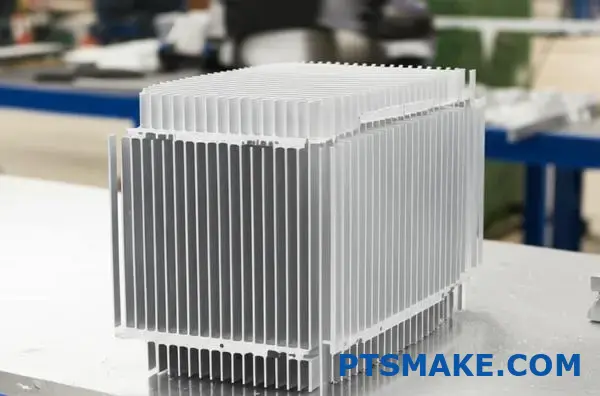
The Manufacturing Difference: Extrusion vs. Skiving
Understanding the manufacturing processes behind these heat sink types provides crucial insight into their performance differences. Having worked with both technologies for various cooling applications, I can attest that the production method significantly impacts the final thermal performance.
Extrusion Process Fundamentals
Aluminum extrusion involves pushing heated aluminum billets (typically 6063 or 6061 alloy) through a shaped die to create a continuous profile. This process, performed at temperatures around 800-925°F (427-496°C), forces the aluminum to take the shape of the die opening.
The key limitations of extrusion directly affect thermal performance:
- Fin Thickness Constraints: Practical limitations typically prevent fins thinner than 1.5mm
- Aspect Ratio Limits: The height-to-width ratio of fins generally cannot exceed 10:1
- Fin Spacing Restrictions: Minimum spacing between fins is limited by die strength and metal flow
These constraints directly impact the surface area available for heat dissipation, which is a primary factor in cooling efficiency.

Skiving Technology Explained
Skiving takes a fundamentally different approach. This process uses precision cutting tools to shave thin fins from a solid metal block. Imagine peeling an apple in one continuous spiral – skiving works similarly but with much greater precision.
The skiving process offers several advantages:
- Ultra-thin Fins: Can achieve fin thicknesses down to 0.2mm
- Higher Fin Density: Can pack many more fins into the same space
- Better Material Options: Works well with copper and aluminum
- Greater Surface Area: Creates significantly more surface area per unit volume
The result is a heat sink with substantially more cooling surface area, which directly translates to improved thermal performance.
Сравнение тепловых характеристик
When evaluating heat sink effectiveness, several metrics help quantify the difference between extruded and skived versions:
| Коэффициент производительности | Extruded Aluminum | Skived Aluminum | Преимущество |
|---|---|---|---|
| Термическое сопротивление | 0.5-2.0°C/W (typical) | 0.2-0.8°C/W (typical) | Skived (40-60% lower) |
| Surface Area Ratio | Base level | 2-3× higher | Skived |
| Fin Density | 5-10 fins per inch | Up to 30+ fins per inch | Skived |
| Использование материалов | Хорошо | Превосходно | Skived |
The thermal resistance difference is particularly significant – lower thermal resistance means more efficient heat transfer from the component to the ambient air. This can translate to cooler component temperatures or the ability to dissipate more heat in the same space.
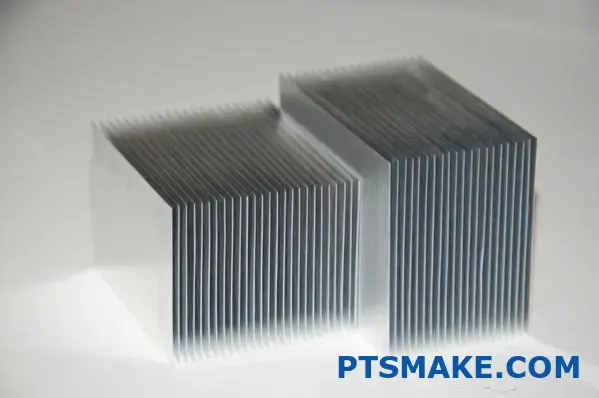
Real-World Performance Testing
In controlled tests we’ve conducted at PTSMAKE, a skived aluminum heat sink typically outperforms a similarly-sized extruded version by 30-50% in natural convection scenarios. The performance gap narrows somewhat with forced convection (using fans), but skived heat sinks maintain a significant advantage.
For example, in one test with a 50W heat source:
- Extruded heat sink: Component reached 85°C
- Skived heat sink (same footprint): Component maintained 65°C
This 20°C difference can be critical for electronic component reliability and performance.
Анализ затрат и выгод
Despite the clear thermal performance advantages of skived heat sinks, cost considerations often drive real-world decisions. Here’s how the two options compare economically:
Manufacturing Cost Factors
Extruded aluminum heat sinks benefit from:
- Lower tooling costs (die costs range from $1,000-10,000 depending on complexity)
- Higher production speeds
- Меньше отходов материалов
- More mature, widely available manufacturing technology
Skived heat sinks involve:
- Более специализированное оборудование
- Slower production rates
- Higher precision requirements
- Более сложный производственный процесс
In general, extruded heat sinks can cost 40-60% less than comparable skived versions when produced in volume. This cost difference must be weighed against the performance benefits.
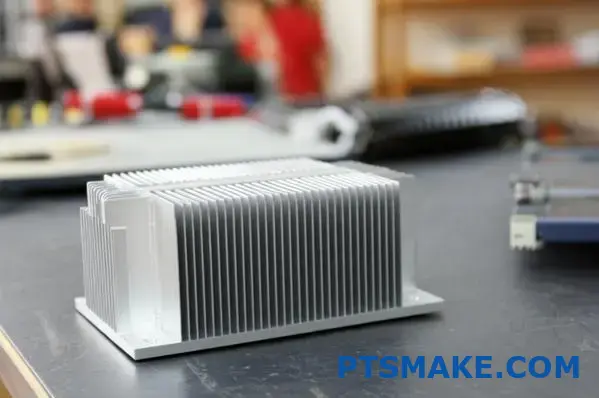
When Each Technology Makes Sense
Based on my experience helping clients select the appropriate cooling solution, I recommend:
Choose Extruded Aluminum Heat Sinks When:
- Бюджетные ограничения являются существенными
- Thermal demands are moderate
- Высокие объемы производства
- The application allows for larger heat sink dimensions
- Natural convection is sufficient
Choose Skived Heat Sinks When:
- Thermal performance is critical
- Space constraints are tight
- Component temperatures must be minimized
- High-power density applications require maximum cooling
- Weight must be optimized against thermal performance
Соображения, касающиеся конкретного приложения
Different industries and applications have unique requirements that may favor one technology over the other:
Бытовая электроника
For laptops, tablets, and mobile devices, the space constraints often make skived heat sinks the better choice despite higher costs. The thin profile and high cooling efficiency allow designers to create slimmer devices without compromising performance.
Силовая электроника
For power supplies, motor drives, and industrial electronics, extruded heat sinks often provide sufficient cooling at a lower cost. The ability to create custom extrusion profiles with mounting features and integration points adds value beyond pure thermal performance.
Светодиодное освещение
LED applications typically benefit from extruded aluminum heat sinks. The moderate heat loads, combined with the need for cost-effective cooling over relatively large areas, play to the strengths of extrusion. Additionally, extrusions can incorporate features for optical component mounting and mechanical attachment.
Телекоммуникации
In telecom equipment, where reliability is paramount and space is often limited, skived heat sinks provide the necessary cooling density. The higher initial cost is offset by improved equipment reliability and density.
Hybrid Approaches and Optimization
In some cases, the best solution combines elements of both technologies:
Base and Fin Optimization
A common approach uses an extruded base with skived fins in critical areas. This hybrid approach:
- Reduces overall cost compared to fully skived solutions
- Provides enhanced cooling where it’s most needed
- Maintains manufacturing efficiency for less critical features
Surface Treatments and Enhancements
Both extruded and skived heat sinks can benefit from:
- Anodizing (improves emissivity and corrosion resistance)
- Surface machining (improves flatness for better thermal interface)
- Advanced coatings (specialized solutions for extreme environments)
These treatments can narrow the performance gap between the technologies in specific applications.
Making the Right Decision for Your Application
When helping clients choose between extruded and skived heat sinks, I recommend considering these factors:
- Thermal Requirements: Calculate the heat load and maximum allowable temperature rise
- Ограничения пространства: Determine the available volume for the thermal solution
- Budget Parameters: Understand both initial and lifetime cost considerations
- Объем производства: Consider how quantity affects manufacturing economics
- Reliability Needs: Assess the consequences of thermal management failure
By methodically evaluating these factors, you can determine whether the superior thermal performance of skived heat sinks justifies their higher cost for your specific application.
In many cases, extruded aluminum heat sinks provide the best value for moderate cooling needs, while skived versions offer superior performance for demanding thermal management challenges where space and weight are premium considerations.
What Are The Cost Benefits Of Choosing Extruded Aluminum Heat Sinks?
Are you struggling to balance your budget with effective thermal management solutions? When cooling critical components, the choice between various heat sink technologies can mean the difference between spending unnecessarily on over-engineered solutions or risking thermal failure with inadequate cooling. The right decision can significantly impact both your project costs and long-term reliability.
Extruded aluminum heat sinks offer substantial cost benefits through lower initial tooling investment, reduced manufacturing complexity, and excellent price-to-performance ratio. The extrusion process allows for cost-effective production of complex cooling profiles in a single operation, eliminating expensive secondary machining while maintaining good thermal performance through aluminum’s excellent thermal conductivity-to-weight ratio.
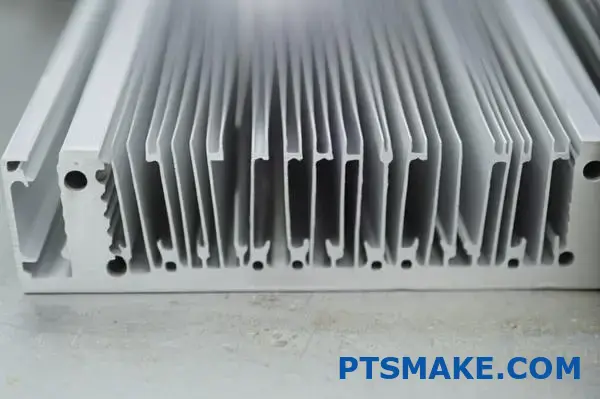
The Economics of Extruded Aluminum Heat Sink Manufacturing
The extrusion process represents one of the most economical methods for producing effective thermal management solutions. Having worked with various cooling technologies throughout my career, I’ve consistently seen extruded aluminum heat sinks deliver exceptional value across diverse applications.
Cost-Effective Production Process
Aluminum extrusion involves pushing heated aluminum billets through a shaped die to create the heat sink profile. This straightforward manufacturing approach offers several economic advantages:
| Фактор стоимости | Extruded Aluminum Advantage | Comparison to Other Methods |
|---|---|---|
| Инвестиции в оснастку | Lower initial die costs | 30-50% lower than die casting molds |
| Скорость производства | High throughput rates | 2-3x faster than machined heat sinks |
| Использование материалов | Минимум отходов | 80-90% material efficiency vs. 30-50% for machining |
| Вторичные операции | Often eliminated | Significant labor/machining cost reduction |
| Потребление энергии | Lower processing energy | Requires less energy than casting or machining |
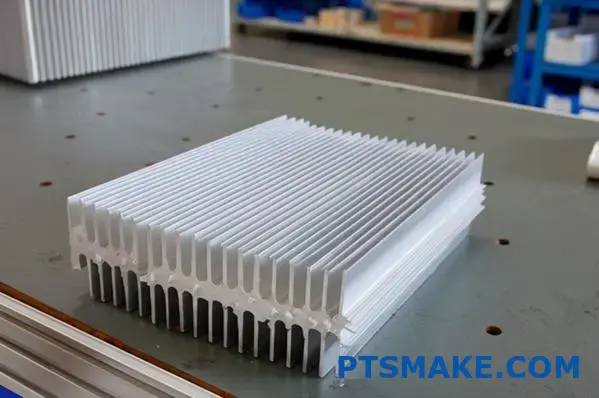
In practical terms, this translates to significant cost savings. For example, when developing cooling solutions for a client’s power electronics application, switching from machined to extruded heat sinks reduced per-unit costs by approximately 40% while maintaining thermal performance within design parameters.
Material Cost Optimization
Aluminum’s inherent properties contribute significantly to the cost-effectiveness of extruded heat sinks:
- Стоимость сырья: Aluminum is substantially more affordable than copper (the next most common heat sink material)
- Весовая эффективность: Aluminum’s low density (approximately one-third that of copper) reduces shipping and handling costs
- Возможность вторичной переработки: High recycling value helps offset initial material investment
- Alloy Flexibility: Various aluminum alloys (particularly 6063 and 6061) offer different cost/performance balances
The material choice alone can represent a 50-70% cost reduction compared to copper alternatives, even before considering manufacturing advantages.
Comparative Cost Analysis: Extrusion vs. Alternative Manufacturing Methods
To fully appreciate the cost benefits of extruded aluminum heat sinks, it’s helpful to compare them directly with other common manufacturing approaches.
Extrusion vs. Machining
| Компонент затрат | Extruded Heat Sinks | Machined Heat Sinks |
|---|---|---|
| Сырье | Lower (uses net-shape forming) | Higher (significant material waste) |
| Расходы на оплату труда | Lower (automated process) | Higher (multiple machining operations) |
| Скорость производства | Higher (continuous process) | Lower (discrete operations) |
| Затраты на оснастку | Moderate one-time die cost | Lower initial, higher ongoing tool costs |
| Минимальное количество заказа | Higher (typically 100+ units) | Lower (can be economical for small batches) |
For medium to high volumes, extrusion typically offers 30-60% cost savings compared to machining, depending on the complexity of the design and production quantity.
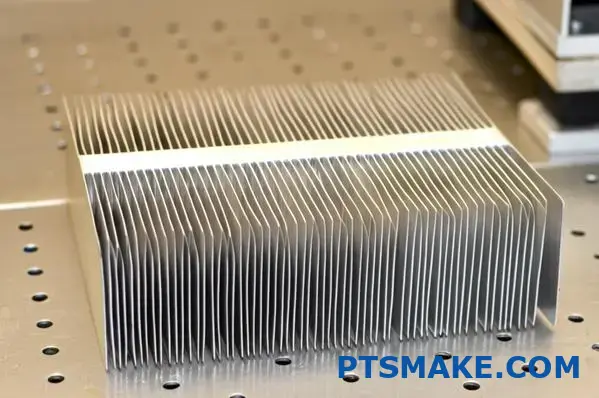
Extrusion vs. Die Casting
| Фактор | Extruded Aluminum | Литой алюминий |
|---|---|---|
| Первоначальные инвестиции | Lower die cost | Higher mold and equipment costs |
| Скорость производства | Very high for simple profiles | Moderate (limited by cooling cycles) |
| Сложность конструкции | Limited to consistent cross-sections | Superior for complex 3D geometries |
| Отделка поверхности | Превосходно | Requires post-processing |
| Свойства материала | Лучшая теплопроводность | Often lower due to porosity |
While die casting offers advantages for complex geometries, the extrusion process typically delivers 20-40% cost savings for suitable designs, particularly those with consistent cross-sections.
Extrusion vs. Skived Heat Sinks
Skived heat sinks, which are created by precision-cutting fins from solid metal blocks, offer superior thermal performance through higher fin density but at a significant cost premium:
| Аспект | Extruded Heat Sinks | Skived Heat Sinks |
|---|---|---|
| Manufacturing Cost | Lower (simple process) | Higher (specialized equipment) |
| Эффективность использования материалов | Хорошо | Превосходно |
| Тепловые характеристики | Хорошо | Superior (higher fin density) |
| Скорость производства | Выше | Lower (more complex process) |
| Minimum Fin Thickness | Limited (typically ≥1.5mm) | Can be much thinner (≥0.2mm) |
In my experience at PTSMAKE, extruded heat sinks typically cost 40-60% less than comparable skived versions, making them the preferred choice for applications where extreme thermal performance isn’t required.
Scale Economics and Volume Production Benefits
One of the most compelling cost advantages of extruded aluminum heat sinks emerges at scale. The economics improve dramatically as production volumes increase.
Tooling Cost Amortization
The initial die investment for extrusion (typically ranging from $1,000-20,000 depending on complexity) can be amortized across large production runs. For example:
- At 1,000 units: Die cost might represent $10-20 per unit
- At 10,000 units: Die cost drops to $1-2 per unit
- At 100,000+ units: Die cost becomes nearly negligible per unit
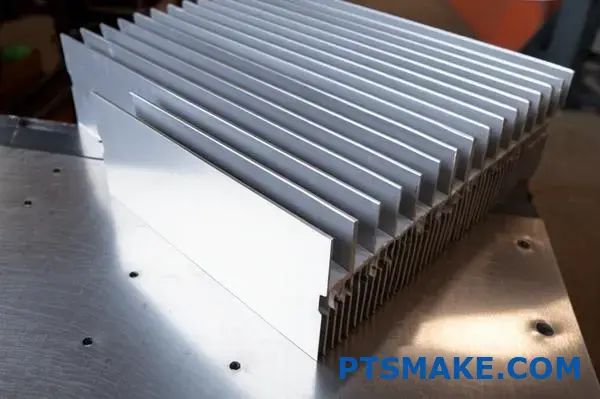
This contrasts sharply with machined heat sinks, where the per-unit machining cost remains relatively constant regardless of volume.
Standardization Opportunities
Another cost advantage comes from standardization. Many applications can utilize standard extrusion profiles, eliminating custom tooling costs entirely. At PTSMAKE, we maintain a library of standard heat sink profiles that clients can leverage to avoid custom tooling charges while still achieving excellent thermal performance.
Design Flexibility Within Cost Constraints
Extruded aluminum heat sinks offer a remarkable balance between design flexibility and cost control:
Integrated Features
The extrusion process allows for incorporation of functional features that would require expensive secondary operations with other manufacturing methods:
- Mounting provisions (T-slots, dovetails, snap features)
- Interface surfaces (precision flatness where needed)
- Структурные элементы (stiffening ribs, interlocking features)
- Multiple thermal zones (varying fin density in different areas)
These integrated features eliminate secondary machining operations, further reducing overall costs. For one telecommunications client, we designed an extrusion that incorporated mounting features directly into the profile, eliminating four drilling operations and reducing assembly costs by approximately 15%.
Customization vs. Cost
While custom extrusion dies have upfront costs, they enable highly optimized designs that can provide better performance-to-cost ratios than generic solutions. The key is finding the right balance:
- For high-volume products, custom extrusions almost always deliver the best long-term economics
- For medium volumes, modified standard profiles (standard extrusions with minimal machining) often represent the optimal balance
- For low volumes or prototypes, standard profiles with mechanical attachment methods may be most economical
Учет стоимости жизненного цикла
Beyond initial manufacturing costs, extruded aluminum heat sinks offer several lifecycle economic benefits:
- Долговечность: Aluminum’s corrosion resistance extends product lifespan in many environments
- Maintenance-Free Operation: No moving parts or degradation over time
- Возможность вторичной переработки: High end-of-life value and environmental benefits
- Снижение веса: In transportation applications, the lightweight nature of aluminum contributes to ongoing fuel or energy savings
When evaluating total cost of ownership, these factors can make extruded aluminum heat sinks even more economically attractive, especially for long-lifecycle products.
Application-Specific Economic Benefits
Different industries and applications derive unique economic benefits from extruded aluminum heat sinks:
Светодиодное освещение
In the competitive LED lighting market, extruded heat sinks offer:
- Low-cost thermal management for price-sensitive consumer products
- Integrated mounting features for optical components
- Ability to serve as both thermal and structural elements
- Aesthetic options through anodizing and surface treatments
The cost efficiency of extruded heat sinks has been a key enabler of affordable LED lighting technology.
Силовая электроника
For power supplies, inverters, and industrial electronics:
- Cost-effective cooling for moderate power densities
- Scalable designs that can be cut to different lengths from the same extrusion
- Integration with enclosure systems
- Good performance in natural convection applications, potentially eliminating fan costs
Бытовая электроника
In computing and consumer devices:
- Affordable thermal solutions for competitive markets
- Weight reduction for portable products
- Design flexibility for aesthetic integration
- Good balance of cost and performance for moderate heat loads
Making Cost-Effective Material Choices
The specific aluminum alloy choice impacts both cost and performance:
- 6063 aluminum: Offers excellent extrudability, good thermal performance, and lower cost
- 6061 aluminum: Provides higher strength with slightly lower thermal conductivity and moderately higher cost
- 6005A aluminum: Balances mechanical properties and extrusion quality at a competitive price point
For most heat sink applications, 6063 represents the optimal balance of cost, thermal performance, and manufacturing properties, which is why it’s our most commonly recommended alloy at PTSMAKE for thermal management solutions.
Conclusion: Balancing Cost and Performance
The decision to use extruded aluminum heat sinks ultimately comes down to finding the optimal balance between thermal performance and cost. In my experience helping clients develop thermal management solutions, I’ve found that extruded aluminum heat sinks represent the best value for approximately 70-80% of applications.
For extreme thermal demands or highly space-constrained designs, more expensive technologies like skived or vapor chamber solutions may be justified. However, for the vast majority of cooling needs, the cost benefits of extruded aluminum heat sinks make them the economically sound choice.
By understanding both the capabilities and limitations of extruded aluminum heat sinks, engineers can make informed decisions that optimize both thermal performance and project economics – delivering solutions that keep components cool without overheating budgets.
Can Extruded Aluminum Heat Sinks Be Customized For Complex Designs?
Have you ever struggled with finding a heat sink that perfectly fits your unique electronic design? Or perhaps you’ve wondered if those standard, off-the-shelf cooling solutions are limiting your product’s potential? Many engineers face this dilemma when standard components just don’t align with their vision for innovative, space-efficient designs.
Yes, extruded aluminum heat sinks can be extensively customized for complex designs. The extrusion process allows for sophisticated cross-sectional profiles that can include various fin geometries, mounting features, and structural elements all in one piece. While there are some manufacturing constraints regarding fin thickness, aspect ratios, and undercuts, modern extrusion technology offers remarkable design flexibility.
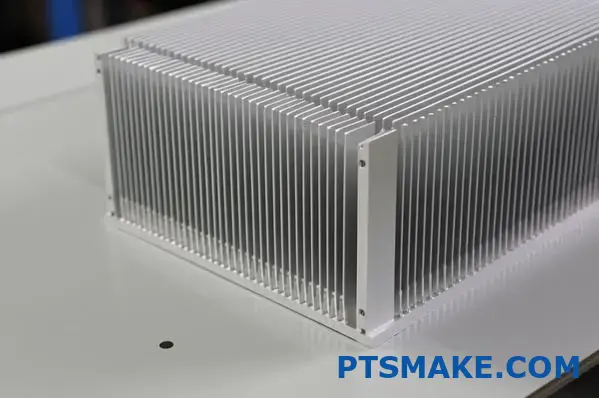
Understanding the Customization Potential of Extruded Aluminum Heat Sinks
The ability to customize extruded aluminum heat sinks offers tremendous advantages for engineers and product designers. Having worked on numerous thermal management projects, I’ve seen firsthand how the right customized heat sink can transform a challenging cooling problem into an elegant solution.
The Extrusion Process and Its Design Flexibility
Aluminum extrusion is a manufacturing process where heated aluminum billets are forced through a shaped die to create a continuous profile with a consistent cross-section. This process allows for remarkable design flexibility within certain parameters:
| Design Aspect | Customization Potential | Ограничения |
|---|---|---|
| Fin Configuration | Variable height, thickness, spacing | Minimum thickness ~1.5mm, aspect ratio limits |
| Base Design | Thickness, width, mounting features | Uniform cross-section requirement |
| Integrated Features | Mounting holes, slots, dovetails | No undercuts perpendicular to extrusion direction |
| Площадь поверхности | Optimized for specific thermal loads | Limited by extrusion constraints |
| Длина | Fully customizable | Limited by extrusion equipment (typically 20+ feet) |
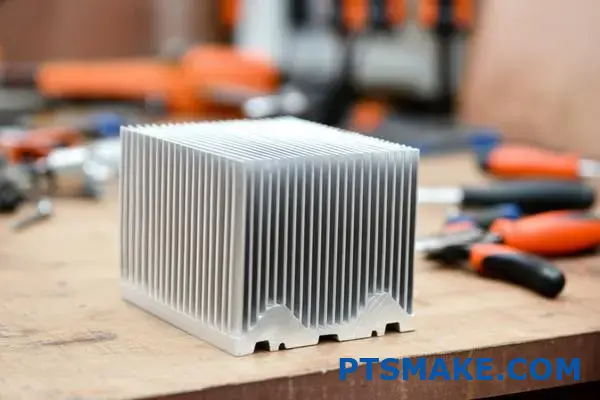
The extrusion die itself represents the heart of customization potential. These precision-engineered tools can be designed to create remarkably complex profiles that would be prohibitively expensive to machine from solid material. At PTSMAKE, we’ve developed hundreds of custom heat sink profiles for applications ranging from power electronics to LED lighting systems.
Customization Beyond Basic Thermal Requirements
Modern extruded heat sinks go far beyond simple thermal functionality. Custom profiles can integrate:
- Mounting Systems: T-slots, dovetails, snap features, and threaded hole preparations
- Структурные элементы: Reinforcing ribs, attachment points, and enclosure integration features
- Interface Provisions: Precision surfaces for component mounting, thermal interface material channels
- Multi-functional Design: Combining thermal management with structural or enclosure functions
This integration capability often eliminates the need for secondary components, reducing overall system cost and complexity. For example, I recently worked with a client to develop an LED lighting solution where the extruded heat sink also served as the primary structural element for the entire fixture, eliminating multiple brackets and fasteners.
Manufacturing Constraints and Creative Solutions
While extrusion offers extensive customization potential, understanding its inherent limitations is crucial for successful design.
Extrusion Design Constraints
The physical realities of forcing aluminum through a die create several design limitations:
- Minimum Feature Size: Generally, fins cannot be thinner than approximately 1.5mm due to metal flow constraints
- Aspect Ratio Limitations: Typically limited to 10:1 height-to-width ratio for fins
- Uniform Cross-Section: The profile must maintain the same cross-section throughout its length
- No Undercuts: Features cannot create "shadows" or undercuts perpendicular to the extrusion direction
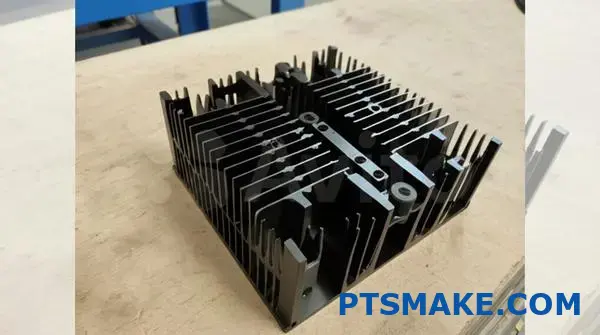
Overcoming Limitations with Hybrid Approaches
Creative engineers find ways to work around these constraints through hybrid manufacturing approaches:
- Post-Extrusion Machining: Adding features like threaded holes, non-uniform cutouts, or variable heights
- Multi-Piece Assemblies: Combining multiple extrusions to create more complex geometries
- Вторичные операции: Adding press-fit components, inserts, or welded elements
- Alternative Fin Creation: Using technologies like skiving or folded fins in critical areas
For instance, we recently developed a cooling solution for a telecommunications client that combined an extruded base with skived fins in high-heat areas, providing maximum cooling exactly where needed while maintaining cost-effectiveness throughout the rest of the design.
Customizing for Specific Application Requirements
Different applications demand unique customization approaches to balance thermal performance, mechanical requirements, and economic constraints.
Thermal Performance Optimization
Custom extrusions allow thermal engineers to optimize cooling specifically for the heat load and airflow conditions of the application:
- Variable Fin Spacing: Creating dense fins in high-heat areas, wider spacing elsewhere
- Pin Fin Designs: For omnidirectional airflow applications
- Angled Fins: Optimizing for specific airflow directions
- Staggered Heights: Maximizing turbulence for better heat transfer
Сайт вычислительная гидродинамика3 simulations we perform before finalizing designs often reveal that well-designed custom profiles can outperform generic solutions by 15-30% in thermal efficiency, even with the same amount of aluminum.
Mechanical Integration Customization
Beyond thermal considerations, custom extruded heat sinks excel at mechanical integration:
- Direct Component Mounting: Creating precision surfaces and mounting features for direct attachment
- Enclosure Integration: Designing profiles that serve as both thermal solution and structural element
- Оптимизация сборки: Incorporating features that reduce assembly time and complexity
- Управление тепловым расширением: Designing mounting systems that accommodate differential expansion
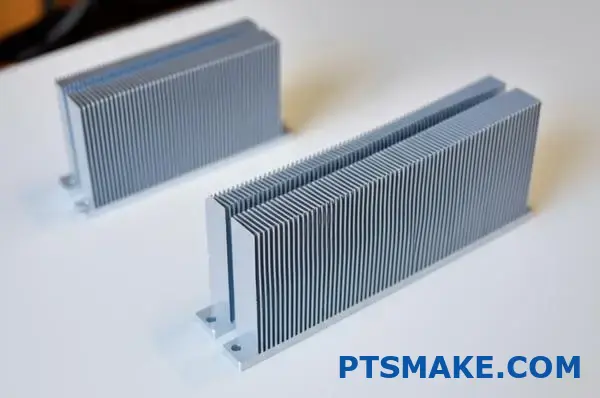
Industry-Specific Customization Examples
Different industries leverage extrusion customization in unique ways:
Светодиодное освещение
- Circular or complex polygonal profiles matching luminaire designs
- Integrated optical component mounting
- Decorative external features for visible applications
- Maximized surface area in compact designs
Силовая электроника
- High-density fin arrays in high-heat regions
- Mounting provisions for multiple power devices
- Bus bar and connector integration features
- Isolation mounting for high-voltage applications
Бытовая электроника
- Low-profile designs for space-constrained products
- Aesthetic considerations for visible components
- Integration with injection-molded assemblies
- Weight optimization for portable devices
The Economics of Custom Extruded Heat Sinks
Understanding the cost implications of customization helps engineers make informed decisions about when custom designs make economic sense.
Tooling Investment and Volume Considerations
Custom extrusion dies typically involve an initial investment:
- Simple profiles: $1,000-5,000 for tooling
- Complex profiles: $5,000-15,000 for tooling
- Precision multi-port designs: $15,000-25,000 for tooling
This initial investment makes custom extrusions most economical for:
- Medium to high production volumes
- Long-lifecycle products
- Applications where performance advantages justify tooling costs
For smaller volumes, modified standard profiles often provide a cost-effective alternative to fully custom designs. At PTSMAKE, we maintain a library of hundreds of standard profiles that can often be adapted with minimal secondary operations.
Value Analysis of Custom Solutions
When evaluating the economics of custom extruded heat sinks, consider these factors:
- Component Consolidation: Eliminating separate mounting brackets, frames, or fasteners
- Assembly Time Reduction: Integrated features can dramatically reduce assembly labor
- Улучшение производительности: Better thermal efficiency may enable smaller overall size or eliminate fans
- Оптимизация материалов: Custom designs often use aluminum more efficiently
In one recent project for an automotive electronics application, the initial tooling investment of $12,000 for a custom profile was recovered in just four months of production due to the elimination of multiple machining operations and separate mounting components.
Design Collaboration Process for Custom Extrusions
Developing effective custom extruded heat sinks requires close collaboration between thermal engineers, mechanical designers, and manufacturing specialists.
Initial Design Considerations
When approaching a custom heat sink design, several factors guide the initial concept:
- Thermal Requirements: Heat load, maximum component temperatures, ambient conditions
- Mechanical Constraints: Available space, mounting interfaces, weight limitations
- Производственные соображения: Extrusion limitations, secondary operations, assembly methods
- Экономические факторы: Production volume, lifecycle, budget constraints
The most successful designs balance these factors rather than optimizing for any single aspect.
Simulation and Prototyping
Before committing to extrusion tooling, thorough validation is essential:
- Thermal Simulation: CFD analysis to predict performance and identify optimization opportunities
- Mechanical Analysis: Structural simulations for mounting stresses, thermal expansion effects
- Разработка прототипа: CNC-machined prototypes for proof-of-concept testing
- Уточнение дизайна: Iterative improvements based on simulation and testing feedback
This verification process ensures the final extrusion design delivers expected performance while remaining manufacturable.
Future Trends in Custom Extruded Heat Sink Design
The field of custom extruded heat sinks continues to evolve with several emerging trends:
- Multi-Alloy Extrusions: Combining different aluminum alloys in a single profile for optimized properties
- Передовые методы обработки поверхности: Micro-textured surfaces for improved heat transfer
- Hybrid Manufacturing: Combining extrusion with additive manufacturing for complex features
- Integrated Thermal Management: Incorporating heat pipes or vapor chambers into extruded bases
- Sustainable Design: Optimizing material usage and selecting alloys with higher recycled content
These innovations are expanding the customization potential of extruded heat sinks, further blurring the boundaries between different cooling technologies.
Ultimately, the remarkable design flexibility of extruded aluminum heat sinks allows thermal engineers to create highly optimized, application-specific cooling solutions that balance performance, manufacturability, and cost-effectiveness. With proper understanding of both the capabilities and constraints, custom extruded heat sinks can solve even the most demanding thermal management challenges.
Learn why the aspect ratio matters for your cooling solution’s efficiency. ↩
Discover how matching thermal expansion coefficients can prevent stress-related failures in your electronic designs. ↩
Learn how computational simulation can optimize your custom heat sink design for maximum cooling efficiency. ↩


